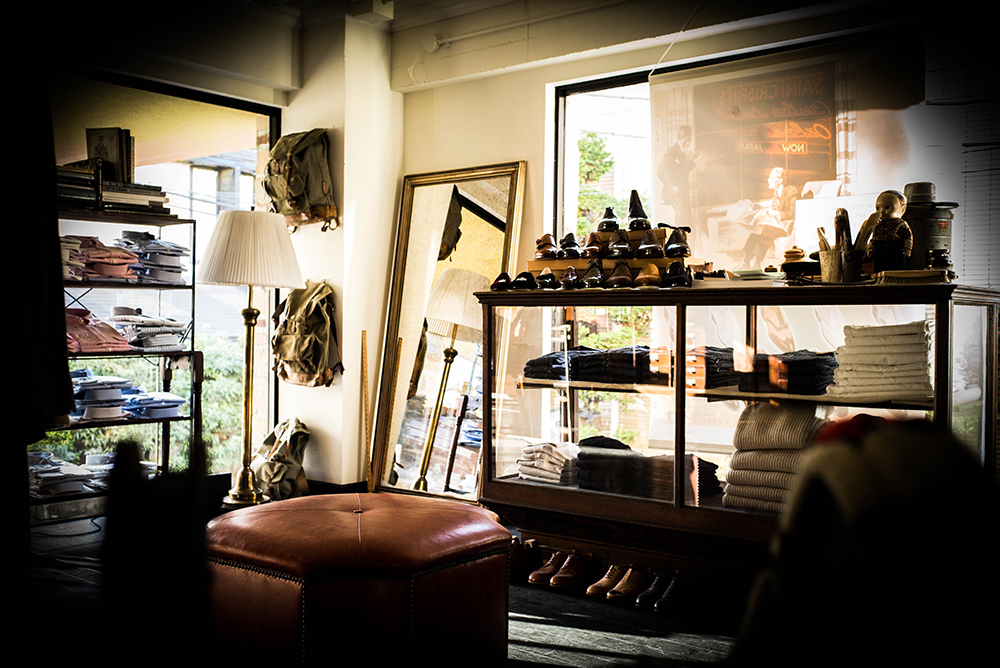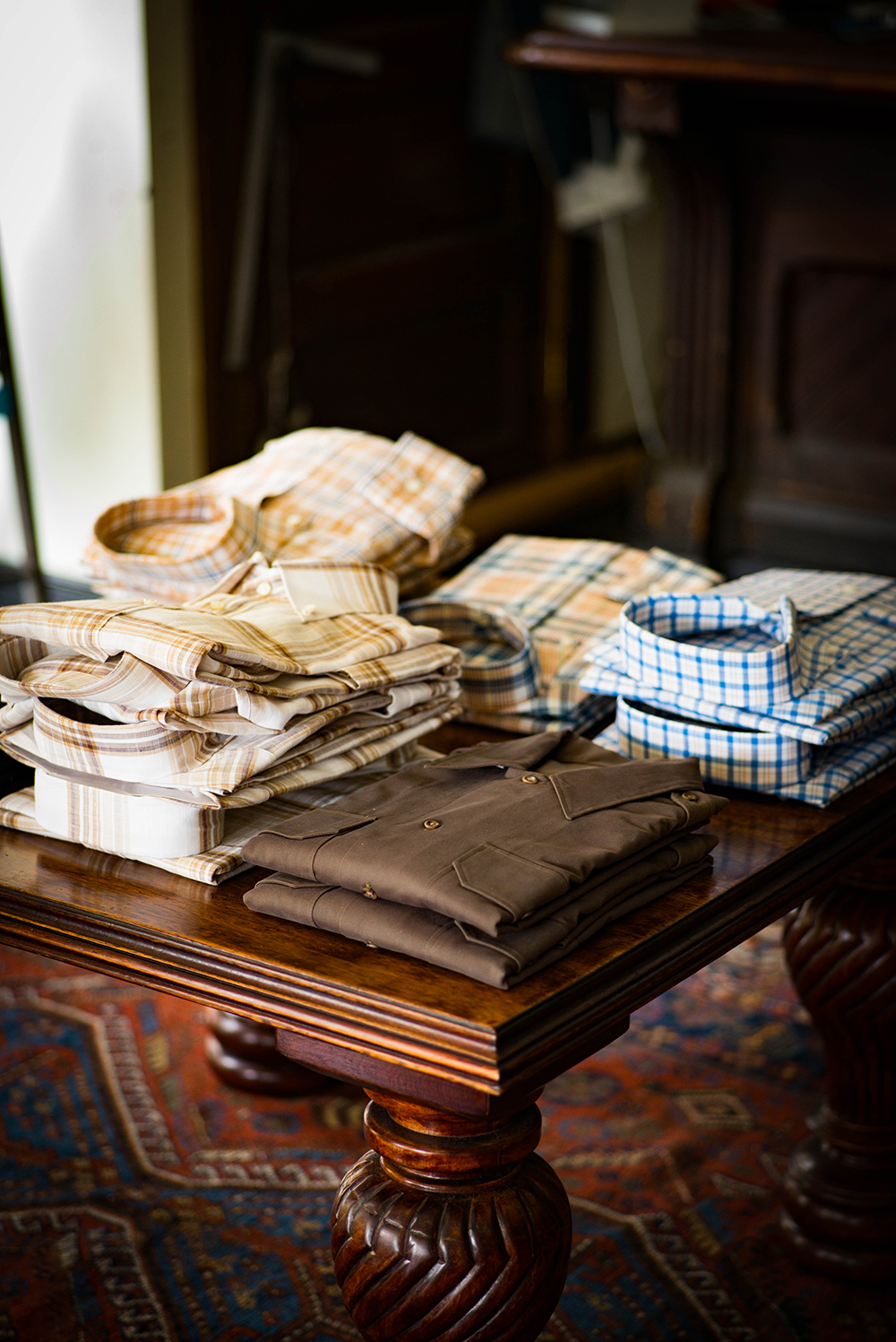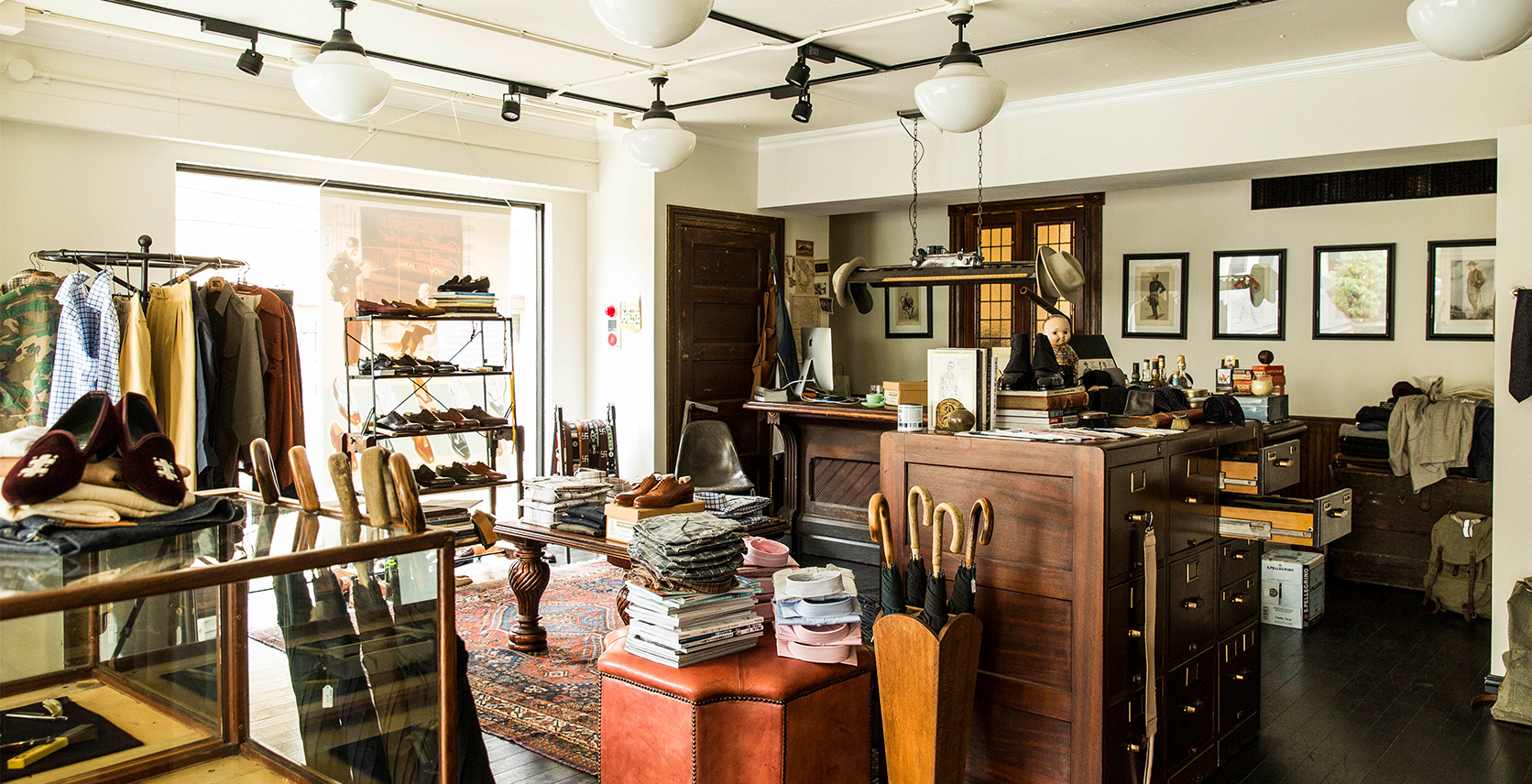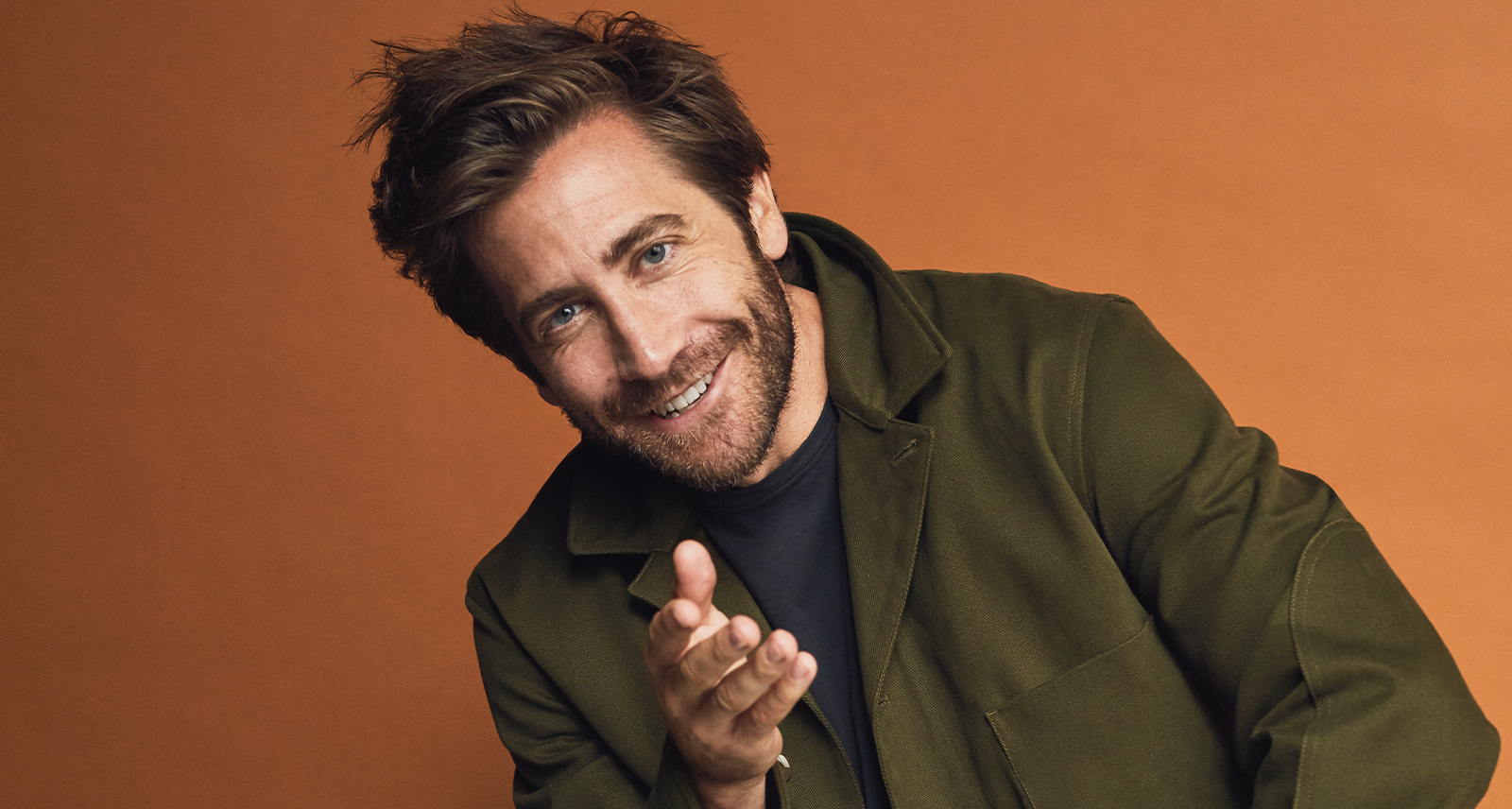How Bryceland’s Australian Owner Opened the Most Buzzed-About Menswear Store in Japan
Ethan Newton’s favourite shirt is, by his own admission, falling apart. He reckons he’s worn the white linen button-down, custom made by Ascot Chang in Hong Kong, twice a week, eight months a year for much of the last seven years. The buttons are chipped, its colour has faded in places, and the monogram has worn away, but he shows these things off with pride and affection, not defects so much as badges of honour. “It’s beaten to shit, the collar is falling apart, the cuffs are separating, but I love the shirt so much that I can’t give it up,” he says. “For me, a shirt isn’t good unless it can get to this state.”
A barrel-chested, six-foot-tall Australian with a thick beard, Bryceland’s owner Newton would stand out on the streets of Tokyo regardless of what he wore, but his clothes certainly don’t help. He arrives to work in a pair of worn-in jeans (a reproduction of a pair of 1955 Levi’s in Japanese denim, he says), a colourful 1950s rayon shirt and a pair of scuffed engineer boots. His wrists are dec- orated in silver Navajo jewelry, and a wide- brimmed felt Stetson sits on his head. He doesn’t particularly look like a traditional tailor, but if you want traditional tailoring, there are lots of other places to find it in this city.
What Newton offers is both an aesthetic and a philosophy, and that’s what his customers come here for. The Bryceland’s look is based on what Newton likes: old-school, confident masculinity, equal parts worn leather, broken-in denim and fine Italian tailoring — the kind of swagger immortalized by men like Marlon Brando, Fred Astaire, and Jimmy Stewart. Classic tailoring’s time as the fashion trend of the moment may have come and gone, but Bryceland’s remains happily stuck in the era of midday scotch and tie clips. Newton’s adherence to tradition has little to do with what’s going on in fashion anyway. “I think guys in that era were wearing the perfect example of their personal uniform, and the proportions were right,” he says. “Broad shoulders, narrow waist, long legs, strong arms…slim, tall, and powerful — that Superman look.” These clothes, made to fit the body rather than to fit a trend, allowed men to dress beautifully, he says. “It made for the most elegant men of all time.”
•••
A short walk from the futuristic streetwear boutiques of Harajuku and the architect-designed flagship stores of Omotesando, Bryceland’s is easy to miss. It’s on a quiet side street, sandwiched between two hair salons, with a small brass plaque by the door among the only signs you’ve found the place. Inside, 1940s big band music is playing, silk ties are laid out in Victorian display cases, and the walls are decorated with portraits of narrow-waisted men in sharply tailored suits. The distinction between this shop and most of its neighbours, however, runs much deeper than decor. Bryceland’s is the culmination of years spent forming and refining a visual code, studying fabrics and tailoring, and learning history and craft. It is Western in form and Japanese in philosophy, a physical embodiment of the man behind it.

Newton’s interest in clothes began in his early teens, when he would buy vintage military jackets, take them apart and reconstruct them to his own specifications. He learned to sew from his mother, a talented seamstress in her own right, while taking style cues from his father. “One of my earliest memories is my dad coming back from Vienna on a work trip when I was maybe 10 years old,” he reminisces. “He’d bought a beautiful double breasted cashmere Ulster-style coat. Every time he was out of the house, I’d go into his wardrobe and put that thing on and walk around in it. It was the coolest thing I’d ever seen in my life.” Newton furthered his skills with a tailoring degree, seeking apprenticeships with as many of Sydney’s designers and tailors as would have him. He practised the craft of sewing and learned the intricacies of production, taking careful note of what he liked and what he didn’t, and developing his opinions for how a man’s wardrobe should look.
Arriving in Tokyo with a Japanese girlfriend he’d met in Australia, Newton abandoned his plans to teach English after a chance meeting with Hidehiko Yamane, founder of the cult denim brand Evisu. After introducing himself to the designer at one of his stores, “We started pouring drinks and he asked me to come out for dinner with him,” Newton recalls. “By the end of the night we were both hammered and he’d offered me a job.” From Evisu he went to work at The Armoury, a prestigious Hong Kong menswear boutique. Here he met Italian tie-makers and English cordwainers, deepening his knowledge of old-world craftsmanship while amassing a loyal roster of customers who shared his love of traditional tailoring.
“The Bryceland’s customer cares about quality, heritage and the unique combination of studied tailoring and devil-may-care ruggedness. It’s Ralph Lauren, but realer. Cooler. A smaller, more exclusive club.”
Then, in 2014, a kind of childhood dream came true when he landed a post as the senior director of men’s luxury brands for Asia at Ralph Lauren. Newton had grown up idolizing the designer’s take on classic Americana. But his increasingly singular vision for the kind of clothes he wanted to make and sell proved an insurmountable obstacle. “I wanted to do something that had the feel of Purple Label or RRL, but I wanted it made properly,” he says, praising his colleagues at Ralph Lauren while lamenting the constrictions of working at a stalwart fashion megabrand. “I wanted a jacket that’s hand-stitched in Naples. I don’t want the feel of vintage Levi’s but the cut of Nudie from the late ’90s. I don’t want it to be something compromised.” This idea of timeless style made authentically and sold without gloss — and free from the demands of a global supply chain — was realized, finally, when he opened the doors to Bryceland’s in 2016.

Newton’s concept for Bryceland’s was to take his love of classic silhouettes and utilitarian menswear and, with the help of his tailoring knowledge and contacts, translate them into a total wardrobe for his clients. He sells made-to-measure suits cut from sturdy wool and linen, and has his jeans and work shirts sewn from the best Japanese denim, embellishing the collection with Canadian-made Himel Brothers leather jackets, English Saint Crispin’s shoes, and vintage military pieces. The Bryceland’s look isn’t outside of fashion — battered Levi’s, Navajo motifs and military jackets have never been more popular in menswear — but that’s not the main reason people come here. The Bryceland’s customer cares primarily about quality, heritage, and Newton’s unique combination of studied tailoring and devil-may-care ruggedness. It’s Ralph Lauren, but realer. Cooler. A smaller, more exclusive club.
•••
Tokyo is perhaps the only place that could support a store like this. In this metropolis of 10 million, which has an astounding array of fashion on offer, people approach their wardrobes with an obsessiveness hard to imagine anywhere else. Newton’s preoccupation with details, craft, and authenticity are characteristically Japanese, as is Bryceland’s guiding principle. The philosophy of sampo yoshi translates to “benefiting in three directions,” and Newton believes his business is obligated to benefit himself, his clients, and his suppliers in equal measure. “The idea is that we create a business where our suppliers are well represented,” he says. “They do what they do really well, and have that explained to the cli- ent properly. Our clients get the best possible product for the best price, and I make enough money to keep the lights on.”
Unlike larger brands, he is not pressured to produce huge collections and move product. He keeps his overhead low and his prices as reasonable as possible. “There’s a lot of pressure in the industry to make it different so that the customer feels obliged to buy again,” he says. “I hate that. I’m not going to compromise what I do or give them a second rate version of what they want.” This pleasure taken in doing a job to the very best of one’s ability, not for personal gain or enrichment but for the satisfaction of it, is also typically Japanese. “My joy is doing my business,” he says. “Not in the peripherals around that, or being a rich guy, which I’m certainly not.” Newton doesn’t want to be a big-name designer, or turn Bryceland’s into a global juggernaut. To do that would be to compromise the thing that makes his shop so special: first and foremost, his presence in it.

Bryceland’s clothes are not inexpensive, but they’re designed to last — to actually improve as you wear them. “I hate anything that doesn’t get better with age,” he says. “Your flannel trousers should be in a hefty flannel that’s going to break down well. Your linen suit should be in a perfect heavyweight linen that’s going to rumple and roll and look better as it ages. If your shoes are at their best the moment you take them out of the box, all you’ve got is disappointment ahead.” He picks up a pair of ten-year-old Saint Crispin’s so worn and scuffed that they look like they might be older than he is. “For me, that’s a perfect shoe,” he says. “That’s what a shoe should look like. There’s no brand-new shoe for any amount of money that looks as good as that.” Everything in the shop is, like these shoes or Newton’s favourite shirt, select- ed with this in mind: to look impeccable when you put it on, and get better over time. If, that is, you share his particular definition of style.










